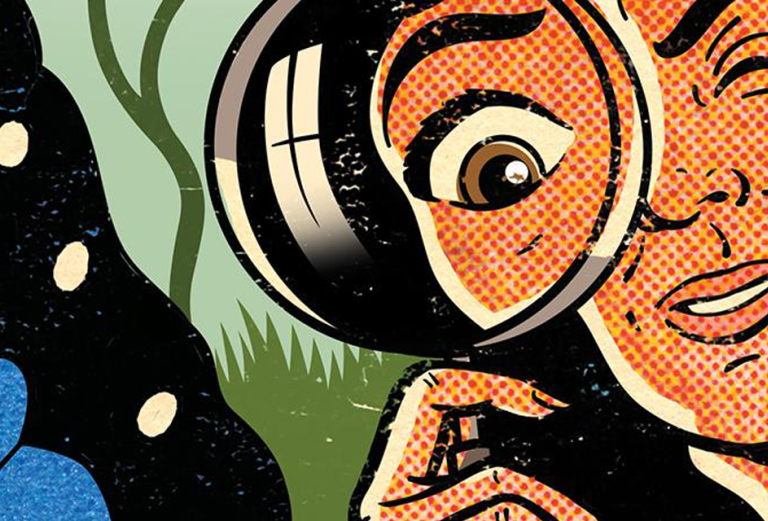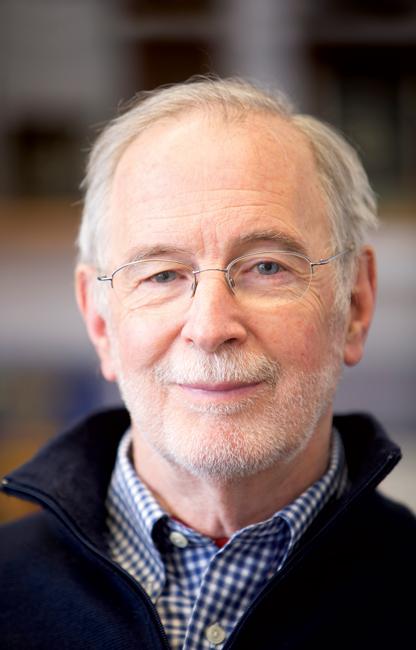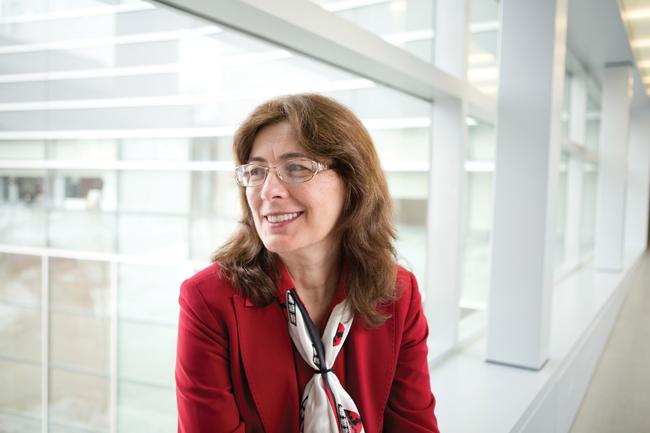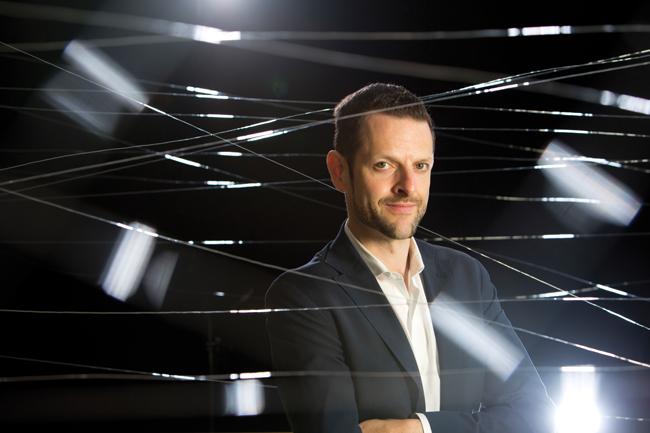Into the Woods
Looking to nature for inspiration allows researchers to think outside the lab
- Feature

Joanna Aizenberg discovers that a butterfly’s wings change color when exposed to liquids other than water and considers how she can integrate that color-tuning property into noninvasive diagnostic devices.
Jeffrey Karp wanders through a cactus garden in Arizona, gauging whether the barbs at the ends of the plants’ delicate spines could inspire improvements in surgical tools.
Jon Clardy heaves aside a shovelful of soil in the Atlantic Forest of Brazil, hoping the bacteria in the ant nest he’s unearthing will lead to a treatment for invasive fungal infections.
For all three researchers, looking to nature inspires unconventional solutions to biomedical problems. Key to their success is an adventurous spirit and an eagerness to veer off the beaten track, literally and conceptually.
“There are many systems I study in nature that nobody has looked at,” says Aizenberg, the Amy Smith Berylson Professor of Materials Science in Harvard University’s School of Engineering and Applied Sciences and leader of the adaptive material technologies platform at the Wyss Institute for Biologically Inspired Engineering at Harvard.
Trying to translate the stickiness of a gecko’s foot into a medical adhesive, as Karp has done, or to find a microbial compound that fights cancer, as Clardy has done, is risky: The likelihood of failure is high, funding is harder than usual to secure, and the path to a result isn’t clear. Even when an effort yields a radical advance, the discovery can be met with resistance.
Some people are frightened by all that uncertainty. But natural product hunters and bio-inspired engineers are driven by it.
Nothing Ventured, Nothing Gained
“There’s adrenaline in this kind of work, but it’s not from fear,” says Clardy, the Hsien Wu and Daisy Yen Wu Professor of Biological Chemistry and Molecular Pharmacology at HMS. “There’s excitement about what you’re going to find, what’s going to be different today from yesterday.”

Whether they’re sampling life forms in far-flung environments or poring over PubMed for ideas, biomedical scientists who explore nature for their inspirations share traits with classic adventurers.
“We’re all equipped with certain tools or skills, we’re advancing with a certain level of confidence that we can make it pretty far, with the belief that we can achieve something new,” says Karp, an HMS associate professor of medicine at Brigham and Women’s Hospital. “But we really never know what’s around the corner.”
“Those who fear the unknown have a difficult time,” he adds. “You have to take all the information you’ve learned, all the skills you’ve acquired, and just leap—and hope for the best.”
These intrepid sorts don’t always land on solid ground. But when they do, they change medicine.
The Great Outdoors
“Look outside,” says Karp. “Every animal, every plant, every living thing has overcome an enormous number of challenges and is full of solutions.”
Sometimes, capturing those solutions for medicine appears straightforward. Poppy plant extracts become opium and then morphine. Brazilian arrowhead viper venom leads to the first ACE inhibitor.
Most of the time, however, says Karp, “You can’t just scrape something off a tree or the bottom of the ocean to solve a medical problem of interest. You need to go beyond nature.”
Researchers like Karp and Aizenberg, who practice bio-inspired engineering rather than biomimicry, aren’t trying to improve upon nature; they’re inviting nature to collaborate or even to be their mentor.
A plant or animal with an intriguing property likely developed it for a different reason, in a different environment, and with materials different from those that would be optimal for medicine. By examining, adapting, and combining those properties, bio-inspired engineers extract new concepts from some of the world’s oldest innovations and devise technologies that produce medical solutions that are effective, stable, scalable, safe, and, not least, customized for use in the human body.
Thief of Nature
When Karp set out to develop a glue that would help surgeons repair septal defects in beating hearts, the criteria were daunting. He knew of materials that would suit the elasticity, biocompatibility, and biodegradability requirements, but he was less sure about the characteristics needed to make something stick in the presence of flowing blood.
So he asked nature, via Google.
He read studies of creatures that exist in wet, dynamic environments, eventually homing in on slugs, snails, and marine sandcastle worms. He learned that their viscous secretions contain hydrophobic agents that resist flowing water.
Attempts by others to develop tissue glue had focused on hydrophilic agents. Karp bet on the slugs and went hydrophobic.
The gamble paid off. The glue repelled blood and held repair patches in place. He made a version that activated with light so surgeons could cure the adhesive on command.
Similar methods have led Karp to develop medical devices that echo characteristics of jellyfish tentacles, porcupine quills, parasitic worms, and spider webs.
Walk on the Wild Side
The glow in a dark corner of a rock shop caught her eye.

While browsing for some shells, Aizenberg followed that glow to its source. It was the exoskeleton of a sea sponge. Turning the pale, webbed tube in her hands, she marveled at how the structure exhibited both strength and luminescence.
Years later, after launching investigations to understand, manipulate, and ultimately exploit the sponge’s unusual characteristics, Aizenberg still appreciates its multifunctionality. She’s fascinated by organisms that have evolved to solve multiple challenges with a single material. She also thinks the best way to adapt organismic solutions for human benefit is to combine properties from many sources.
Aizenberg has created water- and ice-deflecting surfaces that borrow ideas from water strider legs, mosquito eyes, and leaf bristles. The butterfly-inspired color-changing technology, called W-Ink, also owes a debt to beetles and brittlestars. In developing a highly frictionless surface called SLIPS, short for slippery liquid-infused porous surfaces, she took her cue from pitcher plants. A follow-on technology called tethered-liquid perfluorocarbon, or TLP, incorporates self-lubricating features inspired by intestinal mucus and the film that moisturizes our eyes when we blink.
Aizenberg’s goal is to get to the bottom of how each sought-after trait works. Her only limitations: what today’s technology can probe and what is known about the trait’s evolutionary benefit to the organism. Once Aizenberg understands a system, she can play with it.
“I can rationally design it, customize its components, and adjust for what is specific to a particular application,” she explains.
Currently, she has a handful of bio-inspired technologies that can be applied to fields ranging from optics to transportation to building materials to medicine. Coating medical tubing and catheters with SLIPS and TLP, for example, may prevent the formation of blood clots and biofilms.
As they search for new solutions to medical problems, Karp, Aizenberg, and Clardy must think orthogonally. They also must forge their own paths.
Off the Beaten Path
Do these quests for the undiscovered make them modern-day David Livingstones, hacking through jungle until they come upon the biomedical equivalent of Victoria Falls?
“Livingstone and his guides at least knew there was a lake here, a river there,” says Clardy. “We know so little about microbial ecology. It’s more like exploring Mars.”
Antibiotic discovery has slowed in recent decades in part because people keep sampling the same kinds of soil and rediscovering the same compounds. Clardy charts new territory by collecting samples from unexplored or underexplored ecosystems. When he does decide to probe that tired soil, it’s because he’s developed new biochemical techniques to culture bacteria species that have not yet been cultured, ones that have slipped through other scientists’ fingers.
Aizenberg also prefers to strike out into untrodden areas; she avoids investigating materials that obsess others in her field.
“Pretty much everyone who’s talking about developing tough materials is talking about mollusk shells,” she says. “After hundreds of years of research, nobody can replicate that structure. Enough mollusk shells! I want to look for interesting things that others haven’t studied, hidden clues that others haven’t paid attention to.”
Deciding against what Karp calls the “boring linear path” makes the work of these researchers more thrilling—and fulfilling.
“Of course, one can do science by clearly defining the goals and expected outcomes,” says Aizenberg. “But to me that would be boring. When we cannot do something, or the results are absolutely opposite what we expected, then I’m interested. That is an adventure. That’s risk taking. It’s going after serendipitous results.”
This penchant for the path less traveled can have consequences. Aizenberg readily admits her lab publishes less often than others do, opting instead for high impact over frequency. That can not only drive away young researchers, it can place her further from the money.
“The Indiana Jones sort of adventurer doesn’t fare well in the current funding atmosphere,” says Clardy.
But taking risks isn’t the same as recklessness. Clardy, Karp, and Aizenberg make educated guesses about where to look for answers. They build on the work of others. They diversify, knowing not everything will pan out. When Karp and Aizenberg translate natural phenomena into medical devices, they use materials already proven safe in humans. That adds up to a project success rate as high as 50 percent, Aizenberg says.
Still, they’re accustomed to side-eyeing from fellow scientists. Natural product hunting is viewed as offbeat these days, Clardy says. “People used to think I was crazy. They probably still do.”
Their Moments of Zen
Clardy has gone scuba diving for soft corals near mangrove swamps and in the Caribbean Sea. He’s tramped through Costa Rican forests. This summer, he’s heading to Brazil.

He won’t regale you with tales of glamorous exploits, though. To hear him tell it, the corals were “slimy, mucus-producing things.” Digging near the equator was hot, sweaty work, and he had to tape his pants to his boots to keep bugs out. “The whole thing is really kind of grim,” he says.
And yet, “I’d rather be out digging ant nests than sitting in Boston in a snowstorm.”
That’s not only because of the weather. Changing venues changes his routine, which, in turn, can change his way of thinking. Fieldwork also separates him from his electronic devices for most of the day. It has, he says, a contemplative aspect that he enjoys.
The same holds true for Aizenberg, who has been known to spend hours on the beach gazing at the patterns that retreating waves carve in the sand, pondering the complexities of self-assembly.
There and Back Again
At the beginning of The Hobbit, Bilbo Baggins tells the wizard Gandalf, “Sorry! I don’t want any adventures, thank you. Not today!”
He then spends three hundred pages going on a quest with dwarves, getting captured, riddling with strange creatures, and fighting a dragon. But after it all, he’s happy to go home.
Like Bilbo, Clardy, Aizenberg, and Karp are homebodies at heart. They love bench science. Inspiration, after all, can also be found on the computer, at the city zoo, or in the garden.
Karp recalls brainstorming with lab colleagues about animals that “stick into things”: bees, mosquitoes, porcupines. One thing led to another. Now surgical staples inspired by porcupine quills are moving toward large animal studies and, perhaps, to clinical trials.
“And that adventure,” he says, “started right in this office.”
Stephanie Dutchen is a science writer in the HMS Office of Communications and External Relations.
Illustration by Lou Brooks; portraits by John Soares